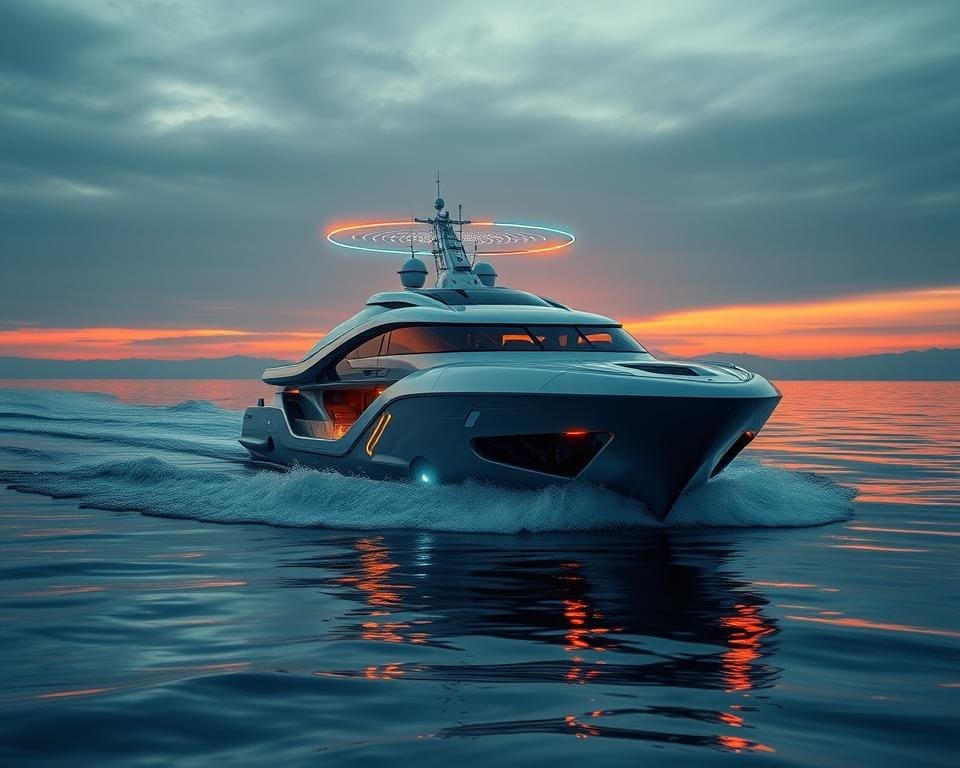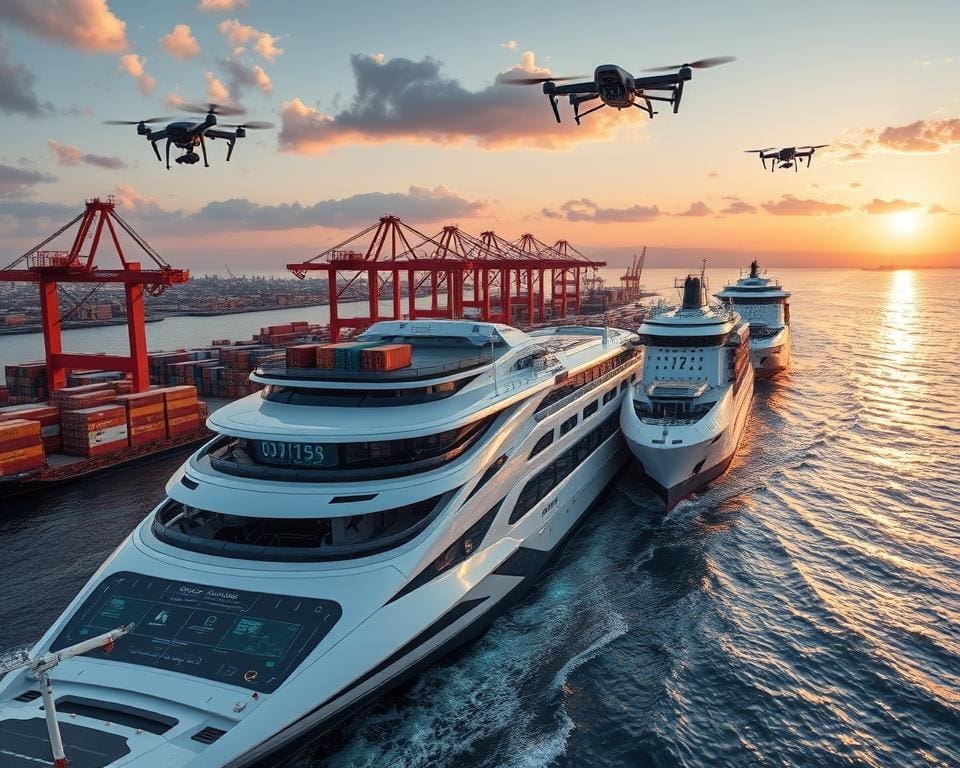As we stand on the brink of a new era, the maritime industry is gearing up for a revolutionary shift with the advent of Automated Ships. These cutting-edge autonomous vessels represent not only a technological advancement but also a transformational force that could redefine the future of shipping. The integration of maritime technology into vessel design promises to enhance efficiency, safety, and sustainability. Companies such as Rolls-Royce and Wärtsilä are at the forefront of this innovation, leading the charge towards a smarter maritime landscape.
The historical context of vessel automation helps to illustrate how far we have come and sets the stage for further exploration into the potential of these automated ships. As we delve deeper into this fascinating topic, we invite you to envision the possibilities that lie ahead for the maritime sector.
The Rise of Automated Ships in the Marine Industry
The journey towards vessel automation has transformed the marine industry, leading to the advent of automated ships that promise to enhance operational efficiency and safety. Understanding these innovations begins with defining what constitutes an automated ship. These vessels can either operate fully autonomously or be remotely controlled, distinguishing them from traditional manned ships. The capabilities of automated systems reduce human error and optimise navigation, resulting in improved safety protocols.
Defining Automated Ships
Automated ships represent a significant leap in maritime technology. Integrating advanced software and sensors, these vessels have various operational modes. Fully autonomous ships conduct operations without any human intervention, while remotely controlled systems allow for human oversight from a distance. This distinction signifies a shift in how vessels are operated, darting towards a future where autonomous vessels could redefine maritime logistics.
Historical Context of Vessel Automation
The roots of vessel automation trace back to early navigational aids, evolving gradually into the sophisticated systems we see today. Historical milestones highlight key developments, such as the launch of Yara Birkeland, heralded as the world’s first unmanned cargo vessel. This groundbreaking achievement sets a precedent, showcasing the potential of automated ships within the marine industry. Each technological advance has built upon previous innovations, paving the way for enhanced operational capabilities in modern shipping.

Understanding the Technology Behind Autonomous Vessels
As the maritime sector embraces innovation, the technology enabling autonomous vessels is becoming increasingly sophisticated. Central to this evolution is the application of AI in maritime, which underpins the functioning of unmanned maritime systems. Understanding the vital technological components helps in appreciating the immense potential robotic vessels hold for the future of shipping.
Role of Artificial Intelligence in Maritime Technology
Artificial intelligence plays a significant role in maritime technology. It empowers unmanned ships to navigate complex environments with minimal human intervention. By employing machine learning algorithms, these vessels can learn from their surroundings, enhancing their ability to make decisions in real-time. Key operations, such as:
- Obstacle avoidance
- Route optimisation
- Environmental monitoring
These operations rely on AI to improve efficiency and safety, making maritime operations more robust than ever.
Key Components of Unmanned Ships
The reliability of robotic vessels hinges on several key components. These systems are designed to work seamlessly, ensuring that unmanned maritime systems function optimally. Essential elements include:
- Sensors: Enabling real-time data collection about the vessel’s environment.
- GPS Technology: Critical for accurate navigation and positioning.
- Communication Systems: Facilitating interaction with shore-based operations and other vessels.
Utilising advanced technologies from prominent companies such as Kongsberg and IBM, the maritime industry is setting a course for a new era in shipping. With these innovations, the deployment of unmanned maritime systems becomes a reality, heralding a transformative shift in how goods traverse our oceans.
Automated Ships: The Next Big Leap in Maritime Tech
The advent of automated ships signifies a monumental shift in maritime technology, revolutionising the landscape of global logistics and trade. By minimising human error, these vessels promise to enhance operational safety and efficiency dramatically. Innovations in this domain may not only reduce costs but also pave the way for *safer* navigational routes.
The transformation from traditional methods to automated shipping serves as a testament to the evolving nature of the industry. Historical examples illustrate how previous advancements have not only improved efficiency but reshaped shipping processes entirely. As maritime technology continues to progress, it is essential to watch for emerging trends that will redefine what the future of shipping looks like.
“Automated ships will reshape global trade routes, making them more efficient and reliable,” noted a prominent industry expert, highlighting the potential shift within maritime operations.
As we venture deeper into this era, the anticipation surrounding automated ships captures the imagination of shipping professionals globally. Embracing these changes could lead to unprecedented opportunities in maritime logistics, pushing boundaries that were unimaginable just a few decades ago.
Impact of Robotic Vessels on Global Trade
The advent of robotic vessels marks a transformative era in global trade, offering revolutionary opportunities for enhancing maritime operations. Examining the implications of these automated ships reveals their potential to significantly influence efficiency and cost-effectiveness in the marine industry. Both businesses and consumers stand to gain from the advancements that robotic vessels bring to the marketplace.
Efficiency and Cost-Effectiveness
Robotic vessels are designed to maximise operational efficiency through automated systems that streamline various processes. Key benefits include:
- Reduced labour costs: With fewer crew members required, companies can allocate resources more effectively.
- Optimised routing and scheduling: Advanced algorithms help determine the best paths, reducing fuel consumption and travel times.
- Enhanced reliability: Automation minimises human error, leading to fewer delays and operational disruptions.
These factors together lead to remarkable cost-effectiveness, allowing companies to operate on tighter margins while maintaining high service levels.
Environmental Considerations
The integration of robotic vessels into trade practices goes hand in hand with environmental awareness. Employing these innovative ships contributes to ecological sustainability by:
- Lowering emissions: Implementing cleaner technologies reduces the carbon footprint associated with maritime transportation.
- Optimising fuel usage: Efficient navigation decreases the consumption of fossil fuels, further mitigating environmental impact.
- Supporting sustainability initiatives: The maritime industry is increasingly focusing on eco-friendly practices, and robotic vessels represent a significant step forward.
Collectively, these environmental considerations position robotic vessels as not just an economic boon but as a vital component in the quest for a sustainable future in maritime operations.
The Future of Shipping: What Lies Ahead for Maritime Technology?
The maritime industry stands on the precipice of transformative change as the future of shipping unfolds before us. As technological advancements accelerate, the adoption of autonomous vessels is set to revolutionise how goods are transported across oceans. With a vision of ‘smart shipping’, vessels equipped with real-time data analytics and predictive maintenance capabilities promise to enhance efficiency and safety within maritime operations.
However, the journey towards a fully automated future is not without its hurdles. Regulatory challenges and the need for international collaboration will shape how rapidly these innovations are adopted. Experts in maritime technology advocate for a unified approach among nations to ensure that the vast potential of autonomous vessels is realised responsibly and effectively.
Predictions from leading maritime futurists highlight a future where shipping is characterised by increased efficiency and sustainability. By integrating advanced technologies into traditional practices, the industry can look forward to a new era of maritime technology that not only optimises operations but also prioritises the well-being of our oceans. The future of shipping is not just about maritime logistics; it’s about creating a sustainable maritime ecosystem for generations to come.









